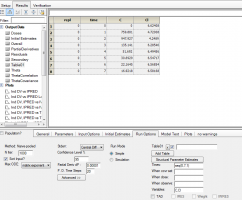Thanks all for organizing this series and it was a great learning resource. I submitted a question at the end of webinar and received a reply thereafter from Chris, shown as follows. Thanks for taking care of the question.
Q: In the structural parameters, we only have CL, but in the fixed effects, we have a, Cl0 and CL, why?
A: In the non-static clearance model, Cl is defined as a function of the fixed effects Cl0 and a. It is not a parameter in itself – it is derived from other parameters.
But still I am little bit confused. When we define Cl = Cl0 - a*C, Cl0 and a are constant parameters and Cl is a variable parameter.
1. Do we have to use stparm to define Cl0 and a as parameters?
2. Is "fixef(tvCl = c(, 4.3, ))" necessary? Cl is dependent on C and therefore changing over time. Should we give it a population mean?
So I am wondering how the model would work with these codes.
test(){
deriv(A1 = - Cl * C - Cl2 * (C - C2) - Cl3 * (C - C3))
deriv(A2 = Cl2 * (C - C2))
deriv(A3 = Cl3 * (C - C3))
dosepoint(A1)
C = A1 / V
C2 = A2 / V2
C3 = A3 / V3
Cl = Cl0 - a * C
error(CEps = 1)
observe(CObs = C * (1 + CEps))
stparm(V = tvV)
stparm(V2 = tvV2)
stparm(V3 = tvV3)
stparm(Cl = tvCl)
stparm(Cl0 = tvCl0) ## what if we add this?
stparm(a = tva) ## what if we add this?
stparm(Cl2 = tvCl2)
stparm(Cl3 = tvCl3)
fixef(a = c(, 0.0005, ))
fixef(Cl0 = c(, 4.3, ))
fixef(tvV = c(, 0.5, ))
fixef(tvV2 = c(, 1.7, ))
fixef(tvV3 = c(, 1.7, ))
fixef(tvCl = c(, 4.3, )) ## what if we remove this?
fixef(tvCl2 = c(, 6.5, ))
fixef(tvCl3 = c(, 2.2, ))
secondary(Min_Cl=Cl0 - a * 1000)
}

















